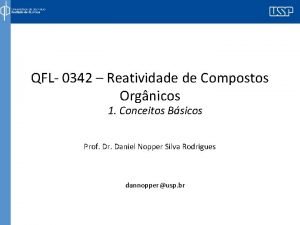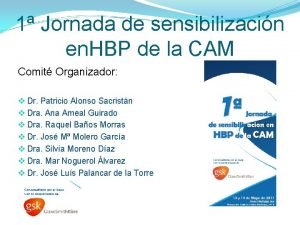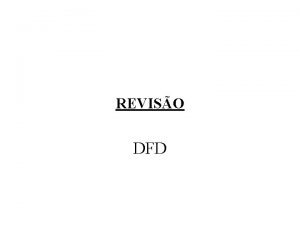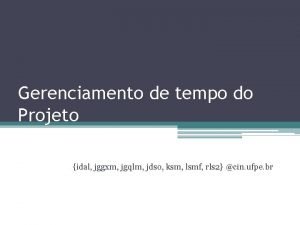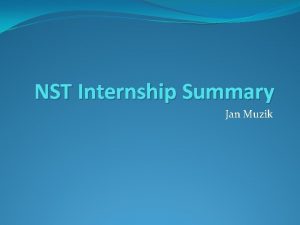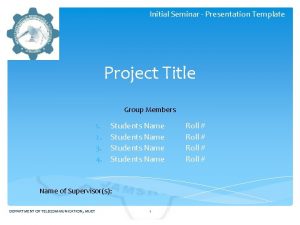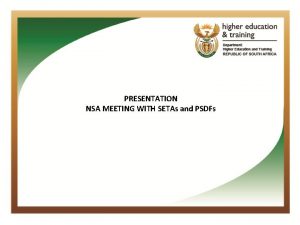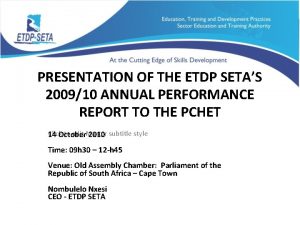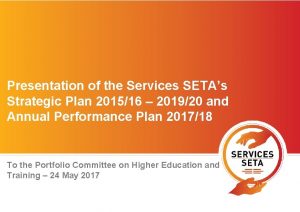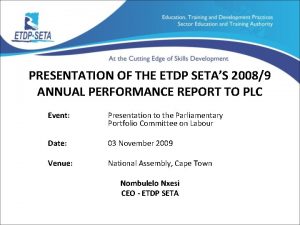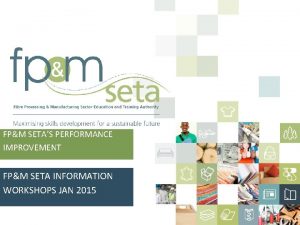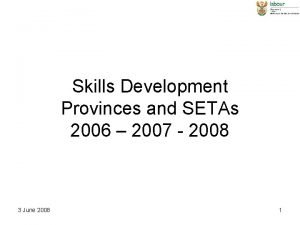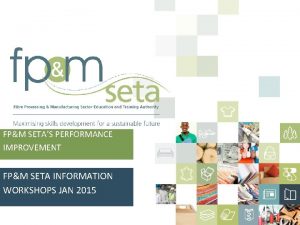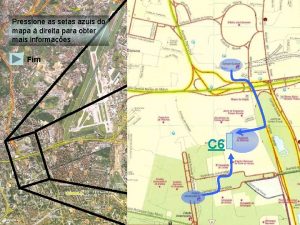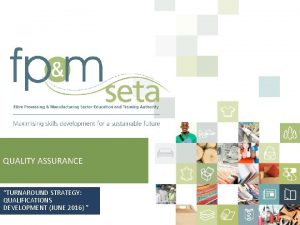212022 212022 PRESENTATION OUTLINE INTRODUCTION ROLE OF SETAs
























- Slides: 24

2/1/2022

2/1/2022 PRESENTATION OUTLINE INTRODUCTION ROLE OF SETAs STRATEGIC DOCUMENTS LEGISLATIVE FRAMEWORK ESTABLISHMENT OF SETAS – SECTION 9 OF SDA FUNCTIONS OF SETAS – SECTION 10 COMPOSITION OF SETAs SETA FINANCES GRANT REGULATIONS FRAMEWORK MONITORING AND EVALUATION OF SETA ISSUING OF INSTRUCTION BY THE MINISTER CLUSTERS KEY PROJECTS/DEVELOPMENTS ON SKILLS DEVELOPMENT DHET EXPECTATION OF SETAS: PRIORITIES

INTRODUCTION The origins of the Skills Development Act and the Skills Development Levies Act lies in a series of policy research processes (e. g. the National Training Board research processes, the National Education Policy Investigation). If employers work in isolation, at individual level, they tend to compete with each other for scarce skills through poaching, resulting in wage inflation and high turnover rates. It is beyond the capacity of individual employers to address scarce skills systematically. This requires sector co-ordination, hence the SETA system which was designed for this type of meso-level co-ordination and collaboration

INTRODUCTION (Cont…) The intention of the SETA system in South Africa was to bring employers and organised labour in a particular sector in the labour market together to drive skills development for the sector. The role of SETAs is to facilitate and co-ordinate skills development in a sector. Core function - identifying skills needs at a sector level, through evidence-led research processes that will identify the critical and scarce skills in the sector, referred to as demand-side analysis.

ROLE OF SETAS Key Objectives: Skills Development Act Develop the skills of the South African workforce to § improve the quality of life of workers, their prospects of work and labour mobility; § improve productivity in the workplace and the competitiveness of employers; § promote self-employment; Increase the levels of investment in education and training in the labour market and improve the return on that investment; Encourage employers to § use the workplace as an active learning environment; § provide employees with the opportunities to acquire new skills; § provide opportunities for new entrants to the labour market to gain work experience; § employ persons who find it difficult to be employed;

Key Objectives: Encourage workers to participate in learning programmes; Improve employment prospects of persons previously disadvantaged by unfair discrimination and redress those disadvantaged through training and education; Ensure the quality of learning in and for the workplace;

Strategic Documents Minister Performance Agreement

Legislative Framework Income Tax Act PFMA Skills Development Act NQF Act Skills Development Levies Act 8

Legislative Framework SETA Landscape and SIC Code Grant Regulations SETA Performance Agreement SETA Constitutions Grant Regulations Notice 9

Legislative Framework Skills Development Act Establishes SETAs, NSA and NSF Skills Development Levies Act (Act 9 of Sets levy at 1% of annual wage bill Sets out exemptions (Act 97 of 1998) 1999) SAQA Act (Act 58 of 1995) SETA Re-certification Regulations (1999) Learnerships (2007) Grant Regulations (2012) Service Level Agreement Regulations (2007) Replaced by NQF Act (February 2009) Transferred to MHE&T (July 2009) Sets criteria for SETA re-establishment Coincides with NSDS periods Stakeholder & NSA public process Regulates structured learning in the workplace Amendments require inclusion of apprenticeships Funding disbursement rules for SETAs and discretionary grants Agreed performance targets for SETAs against SETA business plans and NSDS objectives

Establishment of SETAs – Section 9 OF SDA Sector Education & Training Authorities (21 SETAs - 2011) - National economic sector - Take into account the E&T needs of employers and employees - Uses similar materials, processes & technologies - Make similar products & render similar services

Functions of SETAs – Section 10 Develop Sector Skills Plans within the framework of NSDS Implement Sector Skills Plans by; establishing learning programmes approving workplace skills plans and annual reports allocating grants in the prescribed manner and in accordance with the relevant related regulations monitoring education and skills development provision in the sector

Functions of SETAs (continues) Promote learning programmes by; - identifying workplaces for practical work experience supporting the development of learning programmes improving the facilitation of learning assisting in the conclusion of agreements for learning programmes, to the extent that is required. Register learning programmes agreements Perform any functions delegated by QCTO Submit budgets, financial statements reports, strategic plans and reports on the implementation of SLA to the DG of DHET

Functions of SETAs (continues) Liaise with relevant educational institution/body established under any law regulating education in the Republic to improve information ; About placement opportunities and Between education and skills development providers and the labour market Support FET Colleges and Higher Educational Institutions Implement Government and Sector strategies

Composition of SETAs Independent Chairperson -1 Organised labour -6 Organised business -6 Relevant government departments Interested professional bodies -2 Bargaining council within SETAs jurisdiction Total Minister of DHET approves SETAs constitution = 15

SETA Finances SARS collects levies from employers SETAs levies 20% allocated funding of 80% of skills development Levies allocated to NSF (Surpluses) Grants donation etc

Grant Regulations Framework SARS – 2% NSF – 18% What happens to the 1% Levy? All employers whose gross wage bill exceeds R 500 000 per annum should be paying 1% Skills Development Levies. 17 SETA -10, 5% Mandatory Grant – 20% Discretionary Grant – (49, 5%) (plus any earnings from Interest, Savings or Unclaimed Mandatory Grants) No Surplus from 2014, transferred to NSF Cost Cutting and Expenditure Capping apply (NT) Collection Agent National Priorities as determined by the Executive Authority Administration Managed by the CEO & Management Team QCTO Ministerial determination of 0, 5% Company Skills Planning and Priorities as determined by the Skills Development Committee and Skills Planning Data Sector Priorities as determined by the Seta Board 20% of 49, 5% - Implement SSPs 80% of 49, 5% - PIVOTAL Grants

Monitoring and Evaluation of SETA Signing of SLA by SETA- Section 10 A - Performance of the SETA - Strategic plans – Treasury regulations - Assistance & support - Standards, criteria & NSDS targets for measuring & evaluation - Impact evaluation - annually

Issuing of instruction by the Minister v Mismanagement v Not complying with the SLA v SETAs v At of funds membership not representative the request of the SETA v SETA not complied or implemented the employment equity plan

CLUSTERS 1 Cluster Finance 2 Social 3 Services 4 Goods 5 Resources Five clusters of sectors Sub-sector § Banking § Information Technology § Financial Services § Insurance § Health and Welfare § Education & Training Development § Local Government § Safety and Security § Public Service § Services § Wholesale & Retail § Tourism & Hospitality § Transport § Manufacturing & Engineering § Chemical § Food and Beverage Processing § Fibre Processing § Mining and Minerals § Construction § Agriculture § Energy and Water 20

KEY PROJECTS/DEVELOPMENTS ON SKILLS DEVELOPMENT White Paper NSDS 3 coming to close by end of March 2016 SETA Landscape 2016 - to be determined Ministerial Task Team Report on SETA Performance HRDCSA – Skills System Review Report SETA Turnaround Strategy

DHET EXPECTATION OF SETAs: PRIORITIES Integrating the SETAs in the post-school landscape. Ensuring that SETAs are critical institutions of the economic sectors and not parallel sectors, and they support economic growth and development and priorities of the NGP as well as skills needs of the country. Effective utilisation of the skills development levy resources to support public institutions of education and training. Improve on the functionality of the SETAs to ensure better outcomes that are in line with the amount they manage, they steer their funding towards supporting the priorities of employers and government.

DHET EXPECTATION OF SETAs: PRIORITIES SETAs to facilitate the relationship between employers and public institutions, especially FET colleges to ensure alignment of training programmes and labour market needs. Therefore they need to do better planning in collaboration with FET colleges, Uo. T and Comprehensive Universities. Improve on the functionality of the SETAs – how can they operate as critical institutions that supports the various economic sectors. Increasing stakeholder participation and oversight responsibility over the SETAs.

2/1/2022 Thank You N Questions
 Avaliar para promover as setas do caminho
Avaliar para promover as setas do caminho Ligação química
Ligação química Reação endergônica
Reação endergônica Setas curvas
Setas curvas Setas de silodosina
Setas de silodosina 21 setas
21 setas Dfd
Dfd Diagrama de setas
Diagrama de setas Azure worker role
Azure worker role Interaktionistisches rollenmodell
Interaktionistisches rollenmodell Statuses and their related roles determine the structure
Statuses and their related roles determine the structure Discuss the role of genetic factors in aggression
Discuss the role of genetic factors in aggression What is a quote sandwich examples
What is a quote sandwich examples Hackathon presentation template
Hackathon presentation template Presentation outline slide
Presentation outline slide Presentation outline example
Presentation outline example Research presentation outline
Research presentation outline Pictures of world wide web
Pictures of world wide web Jan muzik
Jan muzik Seminar presentation outline
Seminar presentation outline Training presentation outline
Training presentation outline Mgckey
Mgckey Project presentation outline
Project presentation outline Vertex presentation and cephalic presentation
Vertex presentation and cephalic presentation Cephalic presentation
Cephalic presentation



